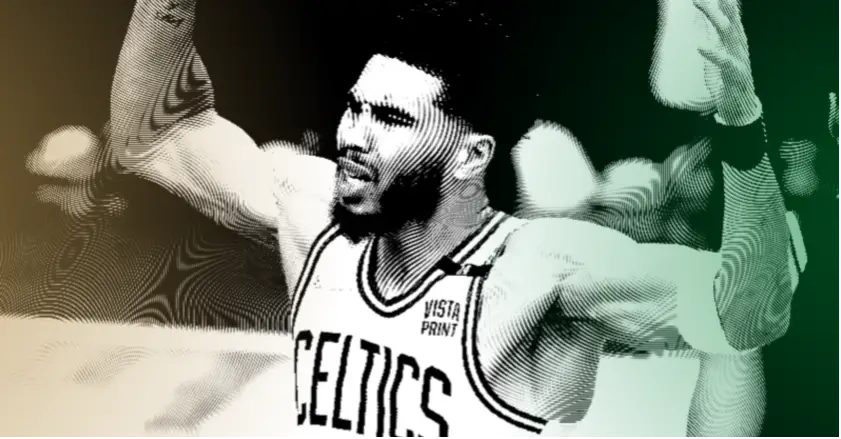The Boston offense has been a problem for much of this series, and a big part of the blame falls on Jayson Tatum.
When a supernova offensive player struggles to score these days, it’s usually because he freezes over from outside. Tatum, however, has actually been lights-out from the perimeter: he’s shooting 47.5% from three on a hefty eight attempts per game! That’s fantastic; by comparison, Steph Curry is hitting “just” 41.7% (albeit on a ludicrous twelve shots per game).
It’s hard for a guy hitting nearly four threes per game to be shooting as poorly as Tatum. But the second he steps inside that arc, a swarming Golden State defense has held him to just 30.6% shooting on two-pointers. Steph Curry is averaging 30.6 points per game (h/t Statmuse for the inspiration). That’s about as bad as a star like Tatum can be.
So what’s going on? Well, we have to start with Golden State reclamation project Andrew Wiggins, who has done a phenomenal job of bodying Tatum and preventing him from going where he wants. Even when the Warriors have switched, they are comfortable having Wiggins stay near the action while someone else helps in the middle. Watch as the Celtics get their desired switch of Nemanja Bjelica onto Tatum after a Rob Williams screen. Tatum tries to drive past Bjelica but runs back into Wiggins, who ignores Williams to zone up in the middle and take away Tatum’s strong right hand. Draymond Green has come over to help on Rob, leaving Grant Williams alone in the weakside corner.
That’s finger-lickin’ good defense all around, particularly by Wiggins to avoid the foul and stay vertical. Tatum has two passes here, a cross-court sling to Grant in the corner or a dump-off to Rob in the paint, but those passes are tough to execute with two Warriors in his face and Draymond lurking underneath. Luka Doncic, Nikola Jokic, or LeBron James could easily make those passes, but not many other guys have the skill and size required to pull those off consistently.
Tatum has seen multiple bodies on almost every foray to the rack. He’s resorted to taking difficult fadeaways, a low-percentage shot at the best of times but even harder on tired legs that carried him around for nearly 45 minutes in Game 5.
The Warriors’ game plan is not complicated. When Tatum (and, to a lesser degree, Brown) drives into the paint, they collapse off Rob Williams and/or weakside shooters to ensure there’s always an obstacle between Tatum and the hoop. Look at this screen capture from Game 4. All five Warriors have two feet touching the paint!
You might think this would leave Golden State vulnerable from outside, and you’d be right: the Celtics have been shooting a superb 41% from deep as a team. The Warriors just haven’t cared, especially since they know Tatum is as likely to turn it over as kick it out to an open shooter. He’s now the single-season leader for most turnovers in one playoff run. That’s partially driven by having played a lot of games, including two different Game 7s. But it’s also a product of his bafflingly inconsistent vision. How can the same guy who made this nifty no-look pass…
…also commit this horrendous turnover?
This isn’t just cherry-picking single instances, either. Tatum consistently has alternated solid (if not beautiful) passes with brain-melting miscues this entire playoff run.
The Warriors have also made a concerted effort to support the little guys on defense. Wiggins has done a good job navigating screens to avoid switching, but when Curry or Jordan Poole do have to pick up Tatum, Jayson faces snarling backup at the hoop. Draymond, Kevon Looney, and even Klay Thompson have been incredibly stout backline help defenders. Tatum has only shot 2-for-21 from two when those three players are the closest defender, although a lot of that is him just missing looks he needs to make:
What can Boston do when Golden State is walling off the rim on Tatum’s drives and the midrange jumper isn’t falling? Tatum isn’t suddenly going to turn into a better passer overnight. We haven’t seen much of Tatum posting up, but there’s a reason for that. According to Synergy Sports, Tatum was in just the 33rd percentile of players for post-up efficiency, and that number has dropped to the 28th percentile for playoff performers. The idea of Tatum executing a quick seal on the block and using his length to lay it up is tempting, but he doesn’t fight hard enough for good position and often settles for those tough fadeaways.
Running more plays that get Tatum the ball on the move is vital so he can make a decisive move before the help can set in. Here, he sets a pick but slips the screen and dusts an uncharacteristically confused Wiggins for an easy bucket (great find from Rob Williams, too):
However, that sort of play can be hard to reproduce regularly. This next one is more replicable (and in fact, Boston has run it several times): Tatum catches the ball and uses a Marcus Smart screen to get an edge on Wiggins. He attacks aggressively, before the help defense can get there, and outmuscles Wiggins for a finger roll:
At the end of the day, Tatum needs to play like a superstar, stop whining about fouls, and get tough buckets. That’s what he’s paid to do. Defenses always load up on the best players, but superstars can rise above and make impossible shots anyway. This is the Finals. Good doesn’t cut it anymore, and great is table stakes; to be a world champion, you must be superlative. Tatum has two chances left to prove he can reach that level.
If you enjoyed this article, please subscribe to basketballpoetry.com to have articles like this delivered directly to your mailbox every Tuesday and Friday! Also, please follow me on Twitter @bballispoetry. Thanks!

